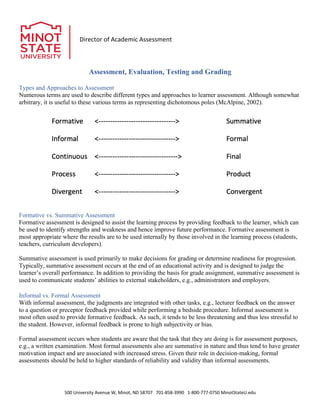
Assessment, evaluation,-testing-and-grading
- 1. 500 University Avenue W, Minot, ND 58707 701-858-3990 1-800-777-0750 MinotStateU.edu Director of Academic Assessment Assessment, Evaluation, Testing and Grading Types and Approaches to Assessment Numerous terms are used to describe different types and approaches to learner assessment. Although somewhat arbitrary, it is useful to these various terms as representing dichotomous poles (McAlpine, 2002). Formative vs. Summative Assessment Formative assessment is designed to assist the learning process by providing feedback to the learner, which can be used to identify strengths and weakness and hence improve future performance. Formative assessment is most appropriate where the results are to be used internally by those involved in the learning process (students, teachers, curriculum developers). Summative assessment is used primarily to make decisions for grading or determine readiness for progression. Typically, summative assessment occurs at the end of an educational activity and is designed to judge the learner’s overall performance. In addition to providing the basis for grade assignment, summative assessment is used to communicate students’ abilities to external stakeholders, e.g., administrators and employers. Informal vs. Formal Assessment With informal assessment, the judgments are integrated with other tasks, e.g., lecturer feedback on the answer to a question or preceptor feedback provided while performing a bedside procedure. Informal assessment is most often used to provide formative feedback. As such, it tends to be less threatening and thus less stressful to the student. However, informal feedback is prone to high subjectivity or bias. Formal assessment occurs when students are aware that the task that they are doing is for assessment purposes, e.g., a written examination. Most formal assessments also are summative in nature and thus tend to have greater motivation impact and are associated with increased stress. Given their role in decision-making, formal assessments should be held to higher standards of reliability and validity than informal assessments.
- 2. 500 University Avenue W, Minot, ND 58707 701-858-3990 1-800-777-0750 MinotStateU.edu Director of Academic Assessment Continuous vs. Final Assessment Continuous assessment occurs throughout a learning experience (intermittent is probably a more realistic term). Continuous assessment is most appropriate when student and/or instructor knowledge of progress or achievement is needed to determine the subsequent progression or sequence of activities. Continuous assessment provides both students and teachers with the information needed to improve teaching and learning in process. Obviously, continuous assessment involves increased effort for both teacher and student. Final (or terminal) assessment is that which takes place only at the end of a learning activity. It is most appropriate when learning can only be assessed as a complete whole rather than as constituent parts. Typically, final assessment is used for summative decision-making. Obviously, due to its timing, final assessment cannot be used for formative purposes. Process vs. Product Assessment Process assessment focuses on the steps or procedures underlying a particular ability or task, i.e., the cognitive steps in performing a mathematical operation or the procedure involved in analyzing a blood sample. Because it provides more detailed information, process assessment is most useful when a student is learning a new skill and for providing formative feedback to assist in improving performance. Product assessment focuses on evaluating the result or outcome of a process. Using the above examples, we would focus on the answer to the math computation or the accuracy of the blood test results. Product assessment is most appropriate for documenting proficiency or competency in a given skill, i.e., for summative purposes. In general, product assessments are easier to create than product assessments, requiring only a specification of the attributes of the final product. Divergent vs. Convergent Assessment Divergent assessments are those for which a range of answers or solutions might be considered correct. Examples include essay tests, and solutions to the typical types of indeterminate problems posed in PBL (Problem Based Learning). Divergent assessments tend to be more authentic and most appropriate in evaluating higher cognitive skills. However, these types of assessment are often time consuming to evaluate and the resulting judgments often exhibit poor reliability. A convergent assessment has only one correct response (per item). Objective test items are the best example and demonstrate the value of this approach in assessing knowledge. Obviously, convergent assessments are easier to evaluate or score than divergent assessments. Unfortunately, this “ease of use” often leads to their widespread application of this approach even when contrary to good assessment practices. Specifically, the familiarity and ease with which convergent assessment tools can be applied leads to two common evaluation fallacies: the Fallacy of False Quantification (the tendency to focus on what’s easiest to measure) and the Law of the Instrument Fallacy (molding the evaluation problem to fit the tool). *This resource is a product of Carnegie Mellon University and Washtenaw Community Colleges and has been tailored to meet the needs of MSU.